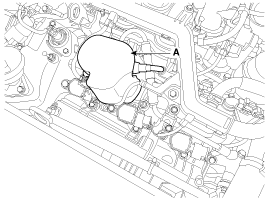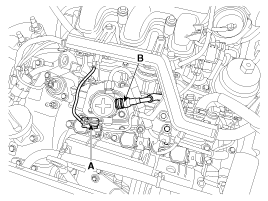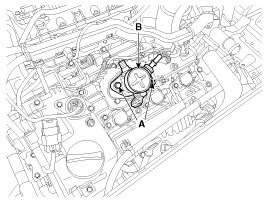 Kia Sedona: Fuel Pressure Control Valve (FPCV) Repair procedures
Kia Sedona: Fuel Pressure Control Valve (FPCV) Repair procedures
Third generation YP (2014-2025) / Kia Sedona YP Service Manual / Engine Control / Fuel System / Engine Control System / Fuel Pressure Control Valve (FPCV) Repair procedures
| Inspection |
| 1. |
Turn the ignition switch OFF and disconnect the battery negative (-) terminal. |
| 2. |
Disconnect the fuel pressure regulator valve connector. |
| 3. |
Measure resistance between the fuel pressure regulator valve terminals 1 and 2. |
| 4. |
Check that the resistance is within the specification.
|
| Removal |
When removing the high pressure fuel pump, high pressure fuel
pipe, delivery pipe, and injector, injury may be caused by leakage of
high pressure fuel. For this reason, do not attempt any repairing
immediately after engine stops.
|
| 1. |
Release the residual pressure in fuel line.
(Refer to the Fuel Delivery System - Repair Procedures - "Release Residual Pressure in Fuel Line") |
| 2. |
Turn the ignition switch OFF and disconnect the battery negative (-) terminal. |
| 3. |
Remove the high pressure fuel fump form (A).
|
| 4. |
Disconnect the fuel pressure control valve connector (A) and fuel feed tube quick-connector (B).
|
| 5. |
Remove the intake manifold.
(Refer to Engine Mechanical System - "Intake Manifold") |
| 6. |
Remove the high pressure fuel pipe.
(Refer to Fuel Delivery System - "Fuel Line") |
| 7. |
Remove the mounting bolts (A), and then remove the high pressure fuel pump (B) from the cylinder head assembly
|
| Installation |
|
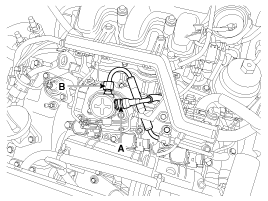
|
|
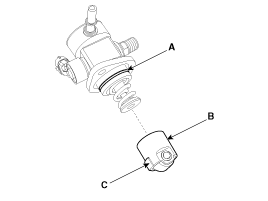
| 1. |
Install in the reverse order of removal.
|
 Fuel Pressure Control Valve (FPCV) Schematic Diagrams
Fuel Pressure Control Valve (FPCV) Schematic Diagrams
Circuit Diagram
...
 Fuel Pressure Control Valve (FPCV) Troubleshooting
Fuel Pressure Control Valve (FPCV) Troubleshooting
Signal Waveform
...
Other Information:
Exhaust Manifold Components and Components Location
Components
1. LH Exhaust manifold gasket2. LH Exhaust manifold3. LH Heat protector4. LH Exhaust manifold stay5. RH Exhaust manifold gasket6. RH Exhaust manifold7. RH Heat protector8. RH Exhaust m ...
Warning message
Type B
Type C
The message will appear to notify the driver there are foreign substances on
the rear bumper or it is hot near the rear bumper. The light on the switch and the
system will turn ...
Categories
- Home
- First Generation
- Second Generation
- Third generation
- Kia Sedona YP 2014-2025 Owners Manual
- Kia Sedona YP 2014-2025 Service Manual
Copyright © www.kisedona.com 2016-2025


